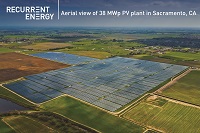


Solar Growth and U.S. Policies
Solar energy is an economic engine that’s driving growth and job creation throughout the United States. This clean, emissions-free technology is becoming increasingly affordable for individuals, businesses, organizations, utilities, the military and other governmental agencies. There are now approximately 120,000 Americans employed in the U.S. solar industry, working at over 5,600 companies, mostly small businesses, across all 50 states. That is double the number of three years ago, and a 240 percent increase since 2008.
These companies are leading rapid innovation across the entire value chain. Manufacturing improvements and technology innovations, as well as new financing and sales mechanisms, are enabling more Americans to go solar.
For the third consecutive year, solar is continuing its phenomenal ascent as it becomes an increasingly mainstream energy resource. The U.S. Solar Market Insight: 2012 Year-in-Review report showed the U.S. solar market grew by 76 percent last year, bringing cumulative solar deployment to more than 7.7 gigawatts – enough to power 1.2 million homes. Nearly half of the cumulative solar capacity deployed in the U.S. – 3,313 megawatts (MW) – was installed in 2012. The market size of the U.S. solar industry grew 34 percent, from $8.6 billion in 2011 to $11.5 billion in 2012.

Driving solar adoption is not just smart business strategy – it’s common sense. It lowers electricity bills, reduces carbon emissions and helps ensure our energy independence and security. Some of the world’s most respected organizations and companies, have embraced solar to power their facilities. So, too, has the U.S. military. As of early 2013, there are more than 130 MW of solar photovoltaic (PV) energy systems powering Navy, Army, Marine and Air Force bases in 31 states and the District of Columbia.
And as the industry continues to scale up, larger solar projects are increasingly added to the grid. This is a trend that will continue as more and more utilities recognize the value of incorporating solar energy into their portfolios.

Solar, Trade Policies and the International Outlook
On the global energy front, solar adoption is growing rapidly worldwide. It’s absolutely critical for the nations of the world to transition to cleaner, safer and affordable sources of energy. In May, atmospheric concentrations of carbon dioxide surpassed a significant milestone — a daily average of above 400 parts per million — for the first time in human history. Solar energy has emerged as an affordable, reliable and practical solution to help the meet the world’s growing energy needs while combating climate change.
Recent imbalances in multiple segments of the solar industry and resulting trade conflicts and disputes threaten to slow solar energy’s growth. Collaboration and competitive cooperation must be pillars of the global trading system. In our trade work, SEIA (Solar Energy Industries Association) advocates for nations around the world to lift localization barriers, and to focus instead on rules-based, World Trade Organization (WTO)-consistent government support measures. SEIA engages with leading global trade associations, government agencies and business leaders to promote the development of the solar industry and its associated economic and environmental benefits. Recently, SEIA and the China Renewable Energy Industries Association (CREIA) joined together to call for an Environmental Technologies Committee within Asia-Pacific Economic Cooperation (APEC). This would create a formal venue within the APEC Secretariat to allow for ongoing dialog on a variety of issues, starting with trade.

By taking these actions, governments and industry together will promote WTO-acceptable trade in solar energy goods; help ensure that global innovation, scaling and economic development occur; and create a collaborative framework for preventing and resolving future trade conflicts should they arise.
Collaboration, negotiation and ongoing dialog are vital to furthering our goals of securing mainstream deployment of solar energy. As the voice of the U.S. solar industry, SEIA believes we must be a proactive leader in the development of a strong system for international trade in solar energy products. We encourage all nations interested in the advancement of solar energy to join together in the development of mutually beneficial policy mechanisms. Success will require global collaboration. Conflict didn’t build our industry -- collaboration did.
The Path Ahead
The year is shaping up to be another exciting one for solar. In the U.S. alone, it’s forecast that an additional 5.2 GW of solar will be installed in 2013. All indications are that solar will continue its phenomenal growth trajectory as one of the largest new sources of energy, and one of fastest-growing industries in the U.S. If we want to create new jobs, foster innovation and ensure prosperity for future generations, we must expand our commitment to using clean, renewable energy sources in the U.S. and around the world.
This transition to sustainable energy sources is vital, and our nation is playing a leading role. All signs point to the fact that the solar industry is a force to be reckoned with; we’re focused on accelerating innovation and adoption as the world shifts to clean, emissions-free technologies – and a safer and healthier planet.

